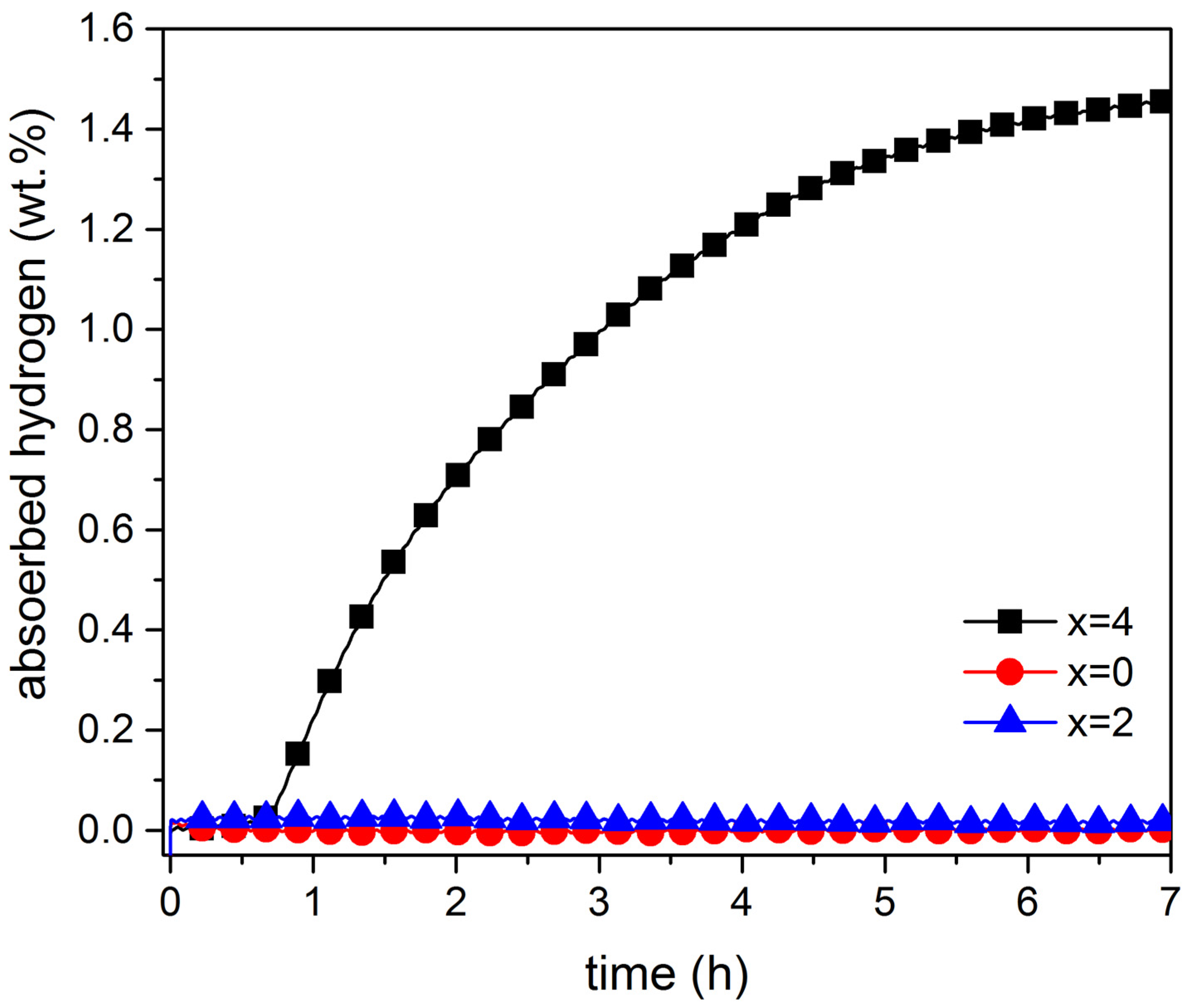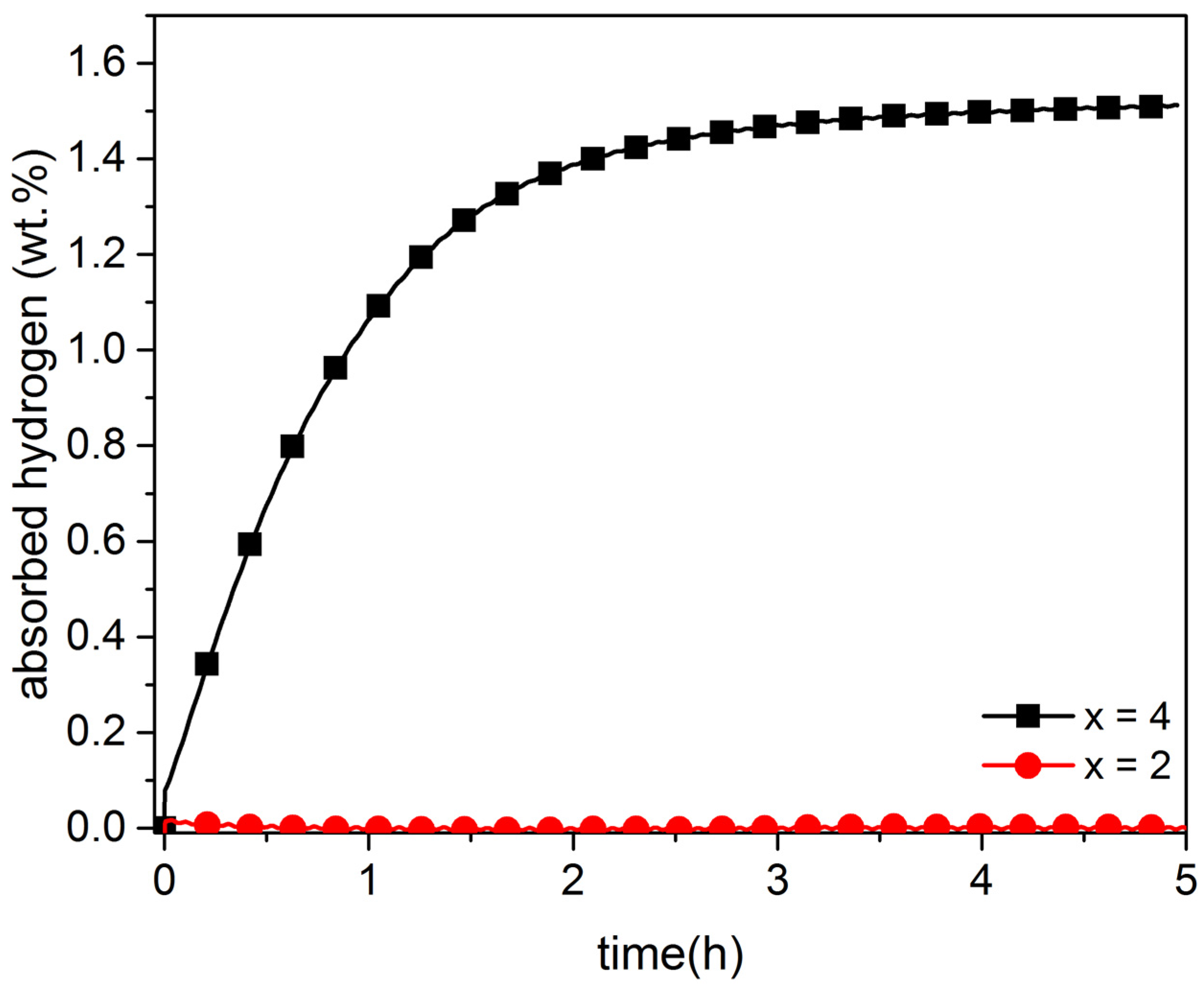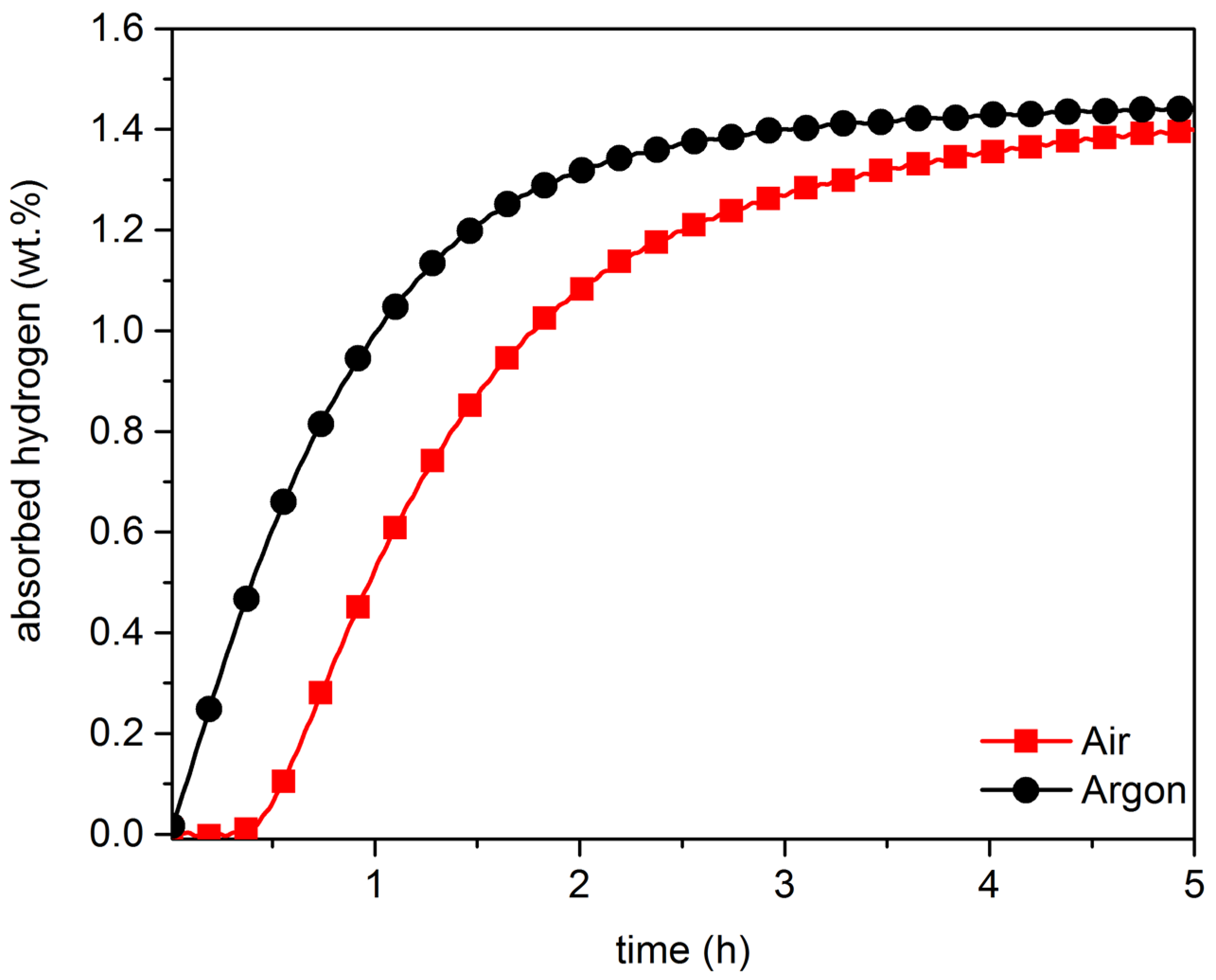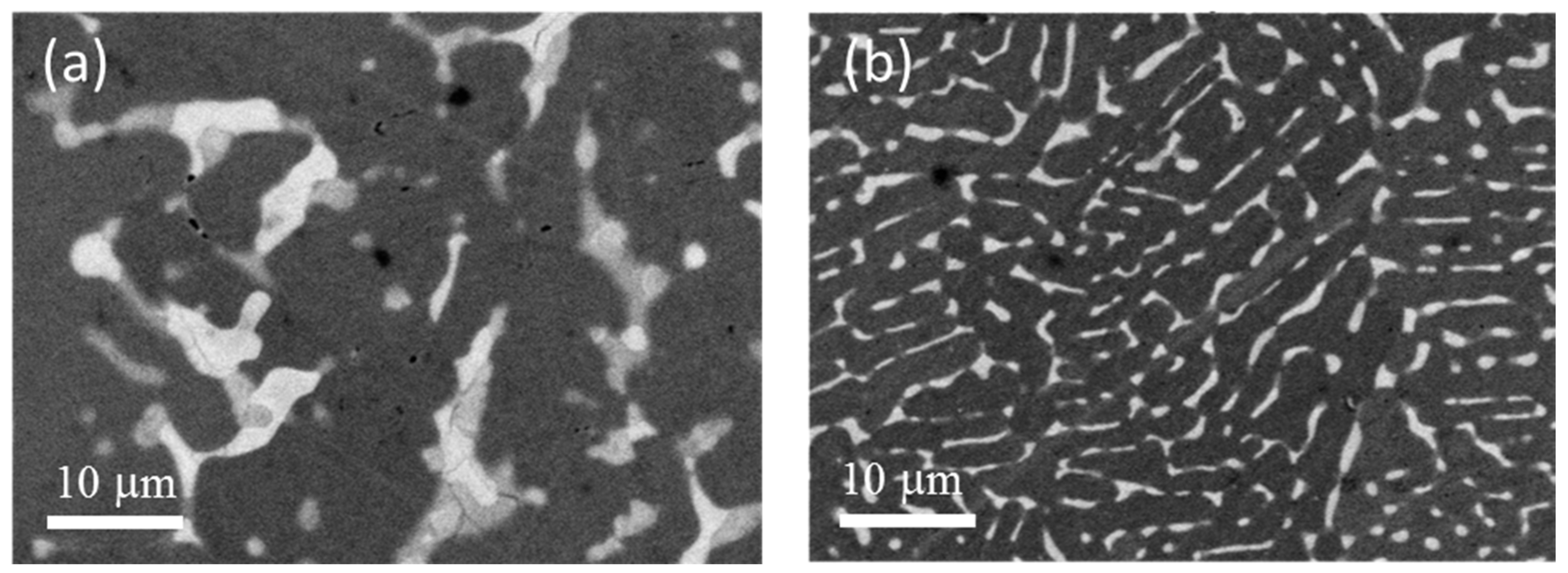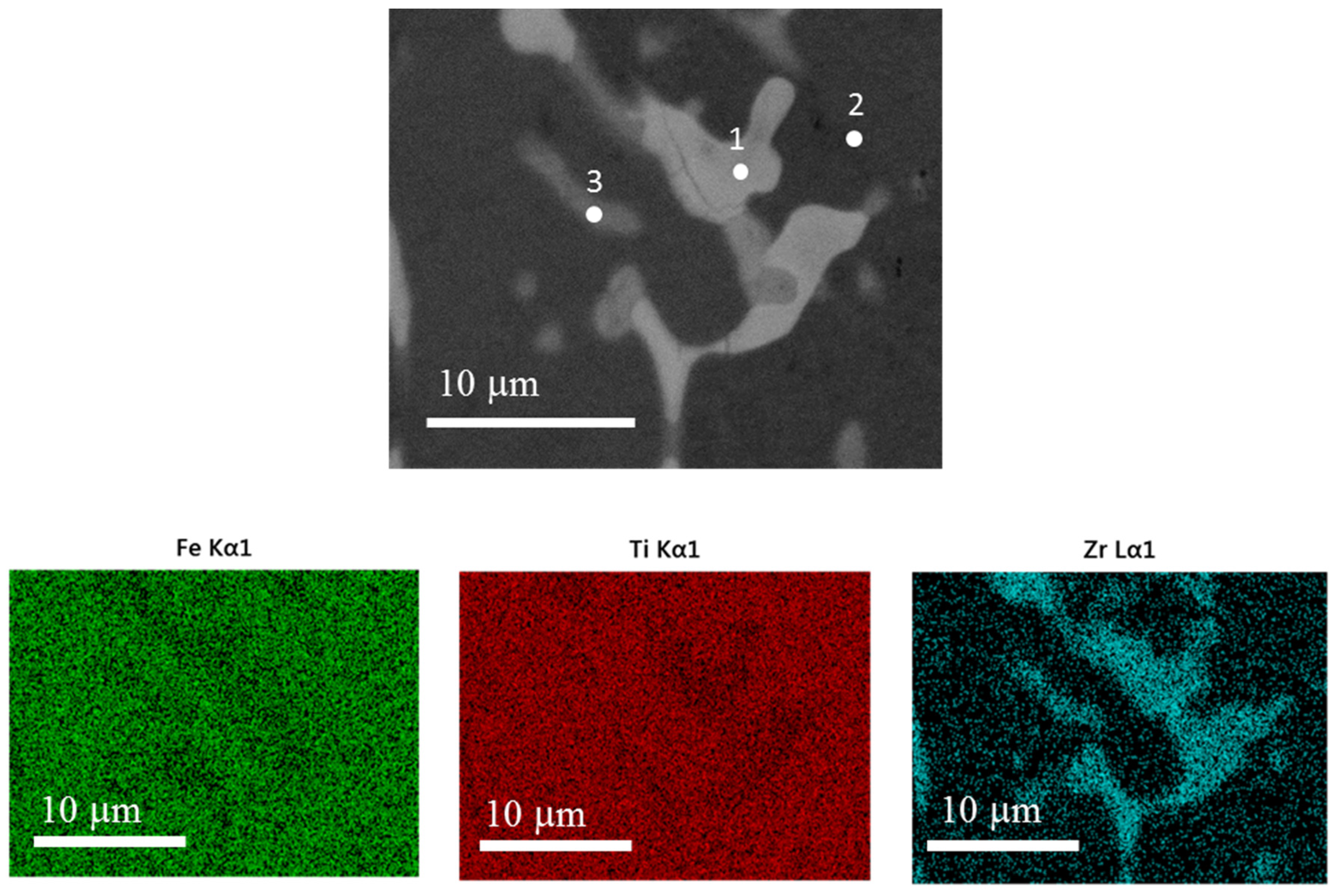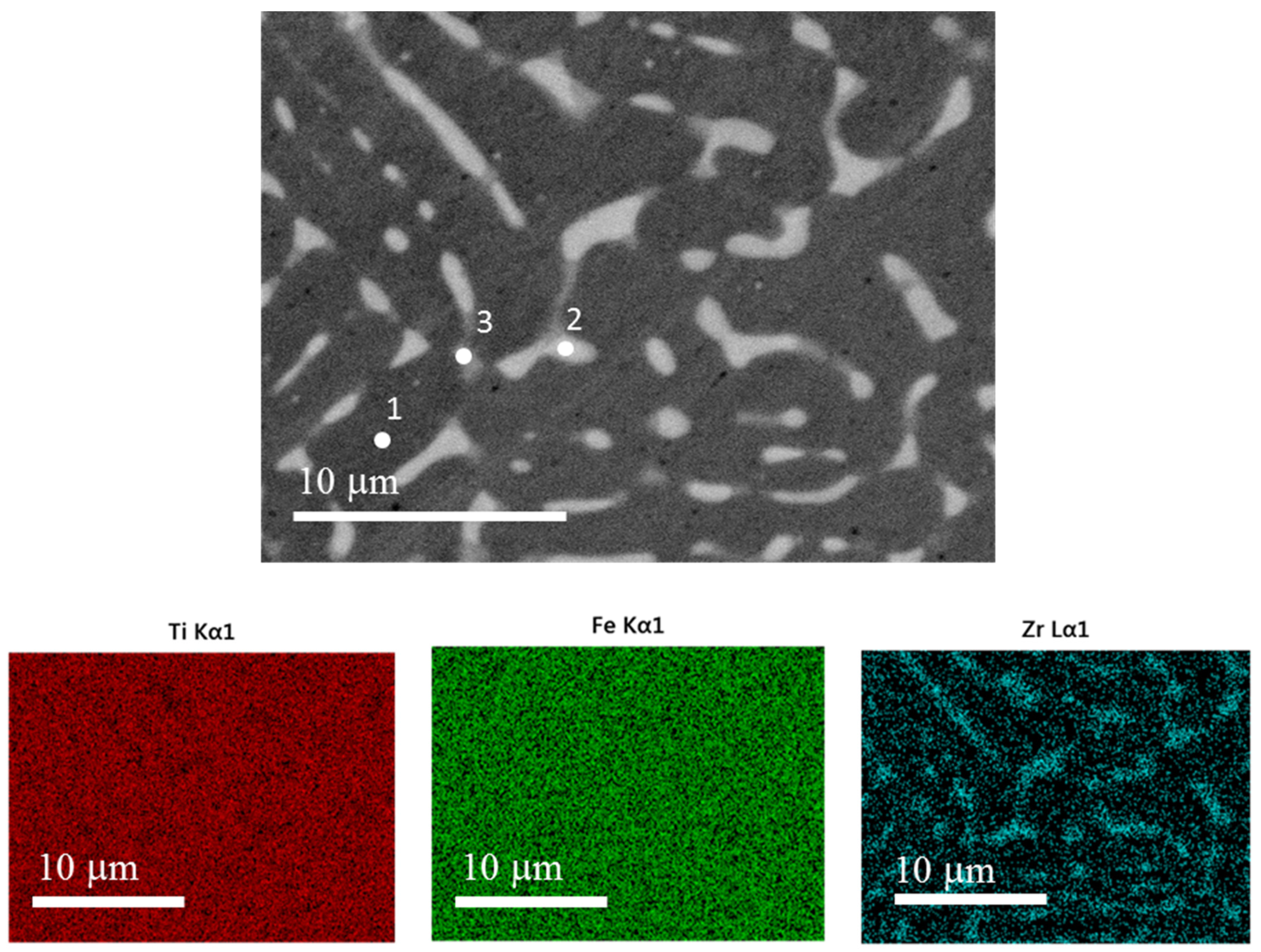2.1. Activation Process
The kinetics of the first hydrogenation, also called activation, of single melt TiFe + x wt.% Zr (x = 0, 2, 4) alloys are shown in
Figure 1. At room temperature, and under a hydrogen pressure of 4500 kPa, the samples with 0% and 2% did not absorb hydrogen, even after seven hours of exposure.
Figure 1.
Activation curves at room temperature under 4500 kPa of hydrogen of single-melt TiFe + x wt.% Zr for x = 0, 2, 4.
Figure 1.
Activation curves at room temperature under 4500 kPa of hydrogen of single-melt TiFe + x wt.% Zr for x = 0, 2, 4.
Addition of 4 wt.% zirconium yielded a significant improvement in activation time. After an incubation time of less than one hour, the alloy started to absorb hydrogen, reaching a maximum storage capacity of 1.45 wt.%.
Figure 2 shows the rate of absorption of hydrogen for co-melt TiFe with a content of 2 and 4 wt.% of zirconium. Under these conditions, and similar to the single-melt sample, the samples with 2 wt.% did not absorb hydrogen, even after five hours of exposure. The sample with 4 wt.% zirconium shows no incubation time and readily absorbs hydrogen. In this case, the maximum storage capacity of 1.59 wt.% was reached after four hours.
Figure 2.
Activation curves at room temperature under 4500 kPa of hydrogen of co-melt TiFe + x wt.% Zr for x = 2, 4.
Figure 2.
Activation curves at room temperature under 4500 kPa of hydrogen of co-melt TiFe + x wt.% Zr for x = 2, 4.
Thus, it is clear that the addition of 4 wt.% of zirconium drastically improves the first hydrogenation (activation) kinetics for both single and co-melt alloys. The main difference between them is that the co-melt alloy does not exhibit an incubation time.
Air Exposure Effect
Being able to handle alloys in air is a critical requirement for large-scale production. For this reason, we tested the effect of air exposure by crushing the alloys in air.
Figure 3 and
Figure 4, respectively, show the activation curve of co-melt and single-melt TiFe + 4 wt.% Zr samples handled in air and in argon.
Figure 3.
Activation curves of co-melt of TiFe + 4 wt.% Zr under Argon and under air, at room temperature, with 4500 kPa of hydrogen.
Figure 3.
Activation curves of co-melt of TiFe + 4 wt.% Zr under Argon and under air, at room temperature, with 4500 kPa of hydrogen.
Figure 4.
Activation curves of single-melt of TiFe + 4 wt.% Zr, under argon and under air, at room temperature. Applied hydrogen pressure is 4500 kPa.
Figure 4.
Activation curves of single-melt of TiFe + 4 wt.% Zr, under argon and under air, at room temperature. Applied hydrogen pressure is 4500 kPa.
For both single-melt and co-melt samples, handling in air result in degradation of activation behaviour. In the case of co-melt (
Figure 3), a short incubation time was present, but, afterwards, the absorption kinetics were very similar to the argon exposed sample.
The single-melt sample handled in air (
Figure 4) presented a much longer incubation time than its argon handled counterpart, but the hydrogenation kinetics after the incubation time were much faster. This led to the unexpected result that full capacity was reached faster in the case of air handled sample. Clearly, the incubation time is linked to the fact that the oxide layers, caused by the exposure to air, prevent the penetration of hydrogen in the alloys. However, presence of some level of oxides may, in fact, speed up the intrinsic kinetics of hydrogenation.
It should be pointed out that the air-exposed alloy did not suffer a significant loss of hydrogen capacity. This could be explained by the fact that, as explained in the Experimental Section, the material was crushed by hand using a mortar and pestle. After crushing, the material is composed of very coarse grains (particles more than 400 μm in diameter), thus, the surface/volume ratio was still very small. This means that, even if the surfaces of particles are oxidized, the volume of oxidized material is still very small. When crushed in air, all surfaces are oxidized and this is the reason for the long incubation time. However, when hydrogen could penetrate this oxide surface, the increases of volume of the hydride phase fracture the material and expose fresh surfaces. This is the reason for the fast kinetics after the incubation time.
2.2. Structure
From the activation measurement reported above, it is clear that activation depends, not only on the chemistry, but also on the synthesis method. This led us to study the alloy’s microstructure and element distribution.
Figure 5 shows the micrograph and element mapping of single-melt TiFe alloy. It is clear that the elements are evenly distributed and, at this scale, there is no intergranular phase. It should be pointed out that the alloy was not etched after polishing. This is the reason why the micrograph appears structureless. The bulk abundance in atomic % of Ti and Fe, as measured by EDX, was, respectively, 50.6 ± 0.1 and 49.4 ± 0.1, which is very close to the nominal composition.
Figure 5.
Secondary electron micrograph and EDX mapping of TiFe alloy.
Figure 5.
Secondary electron micrograph and EDX mapping of TiFe alloy.
Figure 6 shows the micrographs of single-melt and co-melt of TiFe + 4 wt.% Zr alloy. It is clear that the microstructure of these two alloys is totally different. The single-melt alloy has a much smaller and more evenly distributed intergranular phase.
Table 1 shows that the bulk abundance of each alloy, as determined by EDX, agrees with the nominal abundance.
Figure 6.
Secondary electron micrographs of (a) co-melt and (b) single melt TiFe + 4 wt.% Zr alloys.
Figure 6.
Secondary electron micrographs of (a) co-melt and (b) single melt TiFe + 4 wt.% Zr alloys.
Table 1.
Bulk atomic abundance as measured by EDX of TiFe + 4 wt.% Zr single-melt and co-melt alloys. Error on each composition is indicated in parentheses.
Table 1.
Bulk atomic abundance as measured by EDX of TiFe + 4 wt.% Zr single-melt and co-melt alloys. Error on each composition is indicated in parentheses.
| TiFe + 4 wt.% Zr |
|---|
| Alloys | Atomic % |
|---|
| Ti | Fe | Zr |
|---|
| Nominal composition | 47.85 | 47.85 | 4.30 |
| Co-melt | 50.7 (0.2) | 45.8 (0.2) | 3.5 (0.2) |
| Single-melt | 49.0 (0.2) | 48.3 (0.2) | 2.7 (0.2) |
Figure 7 presents a higher magnification micrograph of the co-melt sample, along with element mapping. It is clear that zirconium is mainly located in the intergranular phase. The atomic abundances at specific points indicated in
Figure 7 are listed in
Table 2.
Close inspection of
Table 2 indicates that a small amount of zirconium diffused into the matrix. The two intergranular regions studied seem to have a composition close to (Ti
1-yZr
y)
2Fe. This composition is the one found by Nagai
et al. when they substituted iron with zirconium [
13]. In their paper, they concluded that it was the dispersion of this (Ti
1-yZr
y)
2Fe phase in TiFe alloy that significantly accelerated the activation process. The present results agree with that conclusion.
Figure 7.
Secondary electron micrograph and EDX mapping of TiFe + 4 wt.% Zr co-melt alloy. Numbers in the first image indicate specific points reported in
Table 2.
Figure 7.
Secondary electron micrograph and EDX mapping of TiFe + 4 wt.% Zr co-melt alloy. Numbers in the first image indicate specific points reported in
Table 2.
Table 2.
Atomic abundance at specific points as measured by EDX of TiFe + 4 wt.% Zr co-melt alloy. Error on each number is indicated in parentheses.
Table 2.
Atomic abundance at specific points as measured by EDX of TiFe + 4 wt.% Zr co-melt alloy. Error on each number is indicated in parentheses.
| TiFe + 4 wt.% Zr Co-Melt |
|---|
| Localization | Atomic % |
|---|
| Ti | Fe | Zr |
|---|
| Point 1 (intergranular phase) | 42.2 (0.3) | 39.2 (0.3) | 18.6 (0.2) |
| Point 2 (matrix) | 50.7 (0.3) | 48.6 (0.3) | 0.8 (0.2) |
| Point 3 (intergranular phase) | 51.6 (0.3) | 34.8 (0.2) | 13.6 (0.2) |
The single-melt alloy presents a different microstructure, and element mapping as can be seen in
Figure 8. With respect to the co-melt alloy, the zirconium is mainly located in the intergranular phase.
Table 3 lists the atomic abundance at the specific points marked in
Figure 8.
Table 3 indicates that, as in the case of co-melt alloy, only a small of zirconium diffused into the matrix. Moreover, the amount of Zr in the solid solution in TiFe is the same as the co-melt alloy. Zirconium is mainly present in the intergranular phase, as was seen for the co-melt alloy, but the elemental composition of the intergranular phase is quite different. Here, the stoichiometry is not of the type (Ti
1-yZr
y)
2Fe, but closer to (Ti
1-yZr
y)Fe or (Fe
1-yZr
y)
2Ti. Thus, the distribution and chemistry of the intergranular phase is completely different for the co-melt and single-melt alloys. This may explain the discrepancy in activation behaviour between single and co-melt alloys.
Figure 8.
Secondary electron micrograph and EDX mapping of TiFe + 4 wt.% Zr single-melt alloy. Numbers in the first image indicate specific points reported in
Table 3.
Figure 8.
Secondary electron micrograph and EDX mapping of TiFe + 4 wt.% Zr single-melt alloy. Numbers in the first image indicate specific points reported in
Table 3.
Table 3.
Atomic abundance at specific points as measured by EDX of TiFe + 4 wt.% Zr single-melt alloy. Error of each number is indicated in parentheses.
Table 3.
Atomic abundance at specific points as measured by EDX of TiFe + 4 wt.% Zr single-melt alloy. Error of each number is indicated in parentheses.
| TiFe + 4 wt.% Zr Single-Melt |
|---|
| Localization | Atomic % |
|---|
| Ti | Fe | Zr |
|---|
| Point 1 (matrix) | 50.1 (0.3) | 49.1 (0.2) | 0.8 (0.2) |
| Point 2 (Intergranular) | 39.6 (0.3) | 47.9 (0.3) | 12.5 (0.2) |
| Point 3 (intergranular) | 49.1 (0.3) | 41.6 (0.3) | 9.3 (0.2) |
The hydrogen capacities measured are smaller than the nominal value of 1.86 wt.% for a fully hydride TiFeH2. At this moment we do not have a clear explanation for this fact. However, two possible explanations could be put forward. First, the capacities measured here are for the first cycle (activation). It is well known that, for many metal hydrides, several hydrogenation/dehydrogenation cycles have to be performed before reaching full capacities. In the present case, we have shown that the addition of Zr drastically improves the activation, but it may still be necessary to perform a few more cycles in order to reach full capacity. This is the subject of an ongoing experiment. Secondly, the presence of the intergranular phase may potentially reduce the total reversible capacity. As the intergranular phase seems to form a hydride more easily than the main TiFe phase, we suspect that this phase is much more stable and, thus, may possibly stay in a hydride state during a hydrogenation/dehydrogenation cycle of the main TiFe phase. This is the reason why we did not investigate higher Zr contents. The goal of this study was to find a way to get a faster activation without changing the thermodynamics and capacity of the TiFe alloy. Therefore, we just wanted to add the minimum amount of Zr to improve the activation kinetics.
